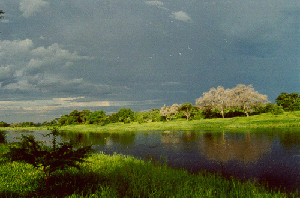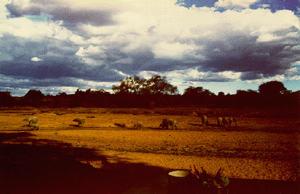>>>page 1 OF 3
>>>NEXT |
>>>you
are here: ACTIVITIES \ The Ruaha National Park\ river |
|
|
The Great Ruaha River
|
 |
 |
|
The Great Ruaha River...Once upon a Time
Ago
|
Elephants digging for water in the dry riverbed
of the Great Ruaha River.
|
| |
|
| |
The Drying of the Great
Ruaha River |
|
To sum-up the situation
briefly, the Great Ruaha flows from south-western Tanzania eastwards,
until it eventually flows into the Rufiji River. During
the mid 1970's a large commercial rice scheme was started in the
Usangu Plains, (Mbarali) which is the main catchment area for the Ruaha.
Subsequent to this scheme, the flow of water during the dry season
began to get less, it was imperceptible at first, however, by the
mid 80's when a second large rice farm was established (Kipunga)
the flow began to diminish more drastically than ever before. In
November, 1993, the river stopped flowing completely for about 3
weeks, in 1994, it was dry for 4 weeks, in 1995 it was dry for 8 weeks
and so on. The situation is now extremely serious with the river
being dry for up to 3 months of the year. Prior to 1993, there are no
records of the Great Ruaha River drying up completely
for any period of time.
|
| |
Naturally,
this has seriously affected the flora and fauna of the river system and
the Park itself. One's immediate thoughts go to the fate of the Hippopotamus
and Crocodiles, which have been severely affected, however, in actual
fact, it is the smaller mammals, birds, and amphibians that are affected
first. The fresh oyster beds are now no more, the endemic fish for the
Ruaha River are now extinct, the White Crowned Plover, whose only breeding
ground in Tanzania is on the Great Ruaha River, is now severely threatened
by lack of success in breeding, this is directly due to the effect of
the drying river. The list is too long to go into here, but suffice to
say that irrevocable damage has already been done.
|
| |
A noticeable
change in the movements of the animals in the park, Elephants and Wild
Dogs in particular. These animals all rely on water from the
Ruaha river for sustenance during the dry season. Now that
this is not available, they are being forced to move away from the
areas along the river in a desperate search for other sources of water.
This will put tremendous pressure on the survival of these species. In
a dry year such as this, it will be difficult for the young animals to
survive such hardships as active springs will be few and far between.
|
| |
The situation
is extremely serious, as, not only without the focus and life force
of the Ruaha river will tourists have no reason to visit the
National Park, but moreover, Ruaha is one of the most
beautiful and important ecological areas due to it's location. It
is on the convergence zone of Northern and Southern species, for example:-
Ruaha Park has over 1,400 species of plants, with at least 15 endemic
plants, as compared to the 600 species found in the Selous or the
Serengeti.
|
| |
It has become
obvious now, that with each passing year, the water that reaches Ruaha
Park from the Usangu basin is decreasing at an alarming rate. In
previous years the Usangu swamp was the ‘source' of the Great Ruaha River.
Each wet season, the Usangu water would begin its journey from Usangu
to the Rufiji Delta, via the Great Ruaha River. At the start of
the rains, the water table in the swamp rose, until it overflowed
from the vast reed beds of the swamps, into the Ruaha River. This water
is of a different colour to the local runoff from rainfall in the Ruaha
Park and so is easy to monitor. It has been dubbed for
many years by the local fishermen, as the ‘black water.
|
| |
The Usangu
water catchment area has been put under tremendous pressure from over
use by rice farming. In the height of the dry season, when the water is
at it's lowest, the rice schemes flood their paddies. One of the
worst aspects of this is that, although vast areas are submerged
in water, not all paddies are utilised, and it often lies wasted and merely
evaporates unused. Recently, the time for flooding has been brought
forward, that is, earlier in the dry season, this enables the stake holders
to obtain higher prices for their rice, though actual annual yield,
remains constant. This earlier season depletes the water reserves
sooner, therefore, downstream, in the Ruaha Park, the river dries up earlier,
leaving increasingly longer periods of drought.
|
| |
Secondly, to
compound the issue, there are thousands of cattle utilizing
the swamp area which is a serious threat on the swamp itself. Tremendous
damage is done by the massive herds that spend the dry season here.
Their hooves trample down the soft spongy surface, thus reducing
the surface area of the swamp drastically each year, not to mention the
vast amount of water that the animals consume daily.
|
| |
As a result
of the obvious overuse and wastage of water up stream from rice
farmers and cattle, no water at all reaches the Ruaha River, not only
during the dry season, but seemingly now during the wet season
as well. Understandably, due to these phenomena, during the wet
seasons, the so called ‘Great Ruaha River' never reaches anything
like its full capacity. As a result, the animals in the Ruaha
Park now face a serious problem of drought conditions.
|
| |
The fact is,
that water abstraction up stream from the Ruaha Park has not only
become greater in volume but also more efficient, or perhaps it
would be correct to surmise that it is less efficient, as more people
move into the area more channels are haphazardly made. There is no system
or control over how the water is used.
|
| |
What is ironic,
however, is that historical records suggest that the Usangu/Ruaha
area during the late 1880's, was regarded as a ‘Garden of Eden, teaming
with wildlife. However, fairly rapidly into the 1900's it becomes
obvious that the area was heavily hunted and the volume of game was drastically
reduced, so much so, that reports suggest that one struggled to see even
an Impala. Since Ruaha was gazetted as a National Park in 1964,
all the money, time and effort spent by TANAPA has made the area
once again a Garden of Eden. Tragically, the very reason for the
game being here in the first place, namely the Great Ruaha River,
is now no longer the life giving force that it was, will the game
survive? What is the future of the Park now? We have the game, but we
don't have the water to sustain it! Does this mean that all the
time and money spent by TANAPA has been in vain? When will
humanity learn to live in harmony with our planet instead of against it?
|
| |
It is important
that all stake holders are made to face up to the seriousness of the situation
and take the initiative to make the necessary compromises on
the short term financial gain. Regulations must be implemented
to ensure that there is some flow reinstated into the Ruaha River
during the dry season. It has been noted that a flow of approximately
5 feet wide, by 12 inches deep was enough to keep the existing
pools with enough fresh water to keep the fish alive, and
keep it sufficiently palatable for the animals to drink. SURELY
one can BEG for such a minute amount of water to continue through the
channels!
|
| |
Unless the
situation of the Usangu Catchment area is taken under control, it seems
likely that the rest of Tanzania's valuable water reserves will follow
a similar fate.
|
| |
One only has
to look at Ethiopia and Kenya to see how devastating mismanagement of
water resources is to National development. We are all aware of
the massive mistakes that have taken place globally, we know the
pitfalls, and Usangu is a classic example.
|
| |
If Tanzania
is to continue to develop for a better future, the ONE resource
that lies at the heart of all life is WATER. So, instead of seeking
more, and more water, by different and more desperate means, efforts should
be made to control our demand, and cut down on the
rampant waste that we see every where.
|
| |
It is imperative,
for the survival of the Nation, that we learn to manage water
as a crucial ingredient to our survival. The Usangu Catchment Project
should be used as a role model leading the way for the rest of Tanzania.
|
| |
The situation is indeed
now CRITICAL. |
| |
For more about the Great Ruaha
River problem or further information about the park:
click Ruaha
National Park.
|
| |
|
>>> CONSERVATION
|

